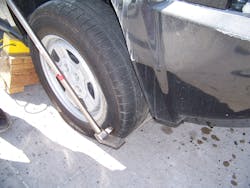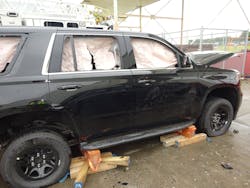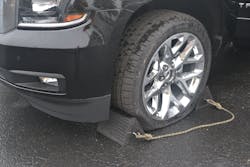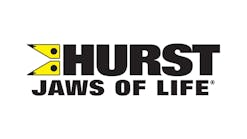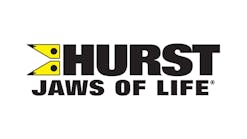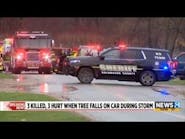University of Extrication: Vehicle Stabilization Evolves
Topic: Stabilization of crash-damaged vehicle on wheels on level surface
Objective: Consider new procedures to meet modern vehicle stabilization challenges
Task: Develop multiple plans for stabilization of a vehicle on four wheels on a level surface when confronted by run-flat tires, high ground clearances and running boards
Vehicle rescue training programs, even at the operations level, always seem to include tools and techniques for the task of vehicle stabilization. That said, there is a need for vehicle rescue personnel to now consider three new stabilization challenges in regard to crash-damaged passenger vehicles that sit on their wheels on a level surface (highway, road, street or the ground): run-flat tires, which don’t require pressurized air inside of them to remain at their full height; high-ground-clearance vehicles (many homemade step chocks don’t suffice for modern SUVs and pickups); and running boards, which interfere with typical stabilization efforts.
Stabilization fundamentals
Procedures that a rescue team implements for stabilization of a crash-damaged vehicle on a level surface that’s resting on inflated tires should address the concept of “chock, block and blow.” To start this process, at least one tire on the drive axle of the vehicle should be chocked with either cribbing or wheel chocks. This prevents unwanted forward or rearward rolling movement.
Next, the undercarriage of the vehicle should be blocked at strategic points to minimize any unwanted side-to-side or up-and-down movement. This usually is accomplished with multiple step chocks, either homemade or commercially available. This is where running boards and high ground clearances can be a challenge.
The final step of the process, referred to as the “blow” portion, involves deflating the tires, which allows the vehicle to settle firmly onto the cribbing. Success can be measured when the weight of the vehicle has settled onto the cribbing and the vehicle’s suspension system has been “relaxed.” This is where run-flat tires (and low-profile tires) can cause issues with stabilization efforts.
Tire deflation normally is accomplished by puncturing the sidewall of the tire with a sharp-pointed tool or by pulling or cutting the valve stem. (Applying an air chuck with a snap-on clip to each valve stem releases air through the valve stem without causing any damage.)Run-flat tires
Although there are numerous tires that function completely without air, the most common tire that resists deflation is the run-on-flat design, or the run-flat tire. Although normally there is pressurized air inside of a run-flat tire, these tires’ thicker and stronger sidewalls maintain just about the same shape/height without pressurized air. Therefore, puncturing the sidewall at a crash scene might be near to impossible because of the thick sidewalls.
Furthermore, with run-flat tires, air pressure must be monitored by an onboard tire-pressure-monitoring system (TPMS). The base of the valve stem has a pressure sensor and transmitter inside of the rim of the wheel. This makes it impractical, if even impossible, to pull a valve stem to release the air that’s inside of the run-flat.
Even if you do figure out a way to release the air on a run-flat tire, it probably won’t result in the tire flattening.
When run-flats are encountered, the most effective procedure might be to chock at least one tire on the drive axle, position the step chocks near their final position, and then have a rescuer accomplish a controlled lift of the vehicle at each fender. This gentle lift, once considered taboo, will allow an assisting rescuer to slide each step chock into position underneath the vehicle. As the vehicle is gently set back down, the step chocks will fully support the weight of the vehicle and allow the suspension system to relax.
High ground clearance
With the popularity of SUVs and pickups, the clearance distance between the ground/roadway and the underside of a passenger vehicle that rescuers will encounter is increasing. What typically used to be only a few inches of ground clearance evolved into 12–13 inches or more, even without any aftermarket modifications. Many a 2010 model year SUV—a vehicle that now is more than 10 years old—has a ground clearance of 13 inches. A late model Chevrolet Tahoe has a ground clearance of 16 inches.
Rescue crews that built their own step chocks by using five layers of wood will find that their step chocks reach only about 8–9 inches in height; of course, that’s far short of even touching the underside of modern SUVs and pickups. In this situation, rescuers must train to grab a step chock and additional cribbing blocks or wedges at the same time. Once the step chock is in position, the added cribbing pieces can be used to raise the step chock until there is vehicle contact.
Many commercially available step chock manufacturers are designing their products to be taller to make the process of stabilization of today’s high-ground-clearance vehicles more efficient.Running boards
More and more, rescuers are encountering crash-damaged vehicles that are equipped with running boards. Of the two major designs of running board, the problem child can be the deployable type. These running boards move from stowed to deployed position based on the opening of the doors. They generally aren’t as strong as fixed running boards are, so they shouldn’t be utilized as stabilization points.
Rescuers most likely will find that fixed (read: permanently mounted) running boards are stronger in their construction and are securely anchored to the vehicle frame or unibody structure. This allows them to be used as stabilization contact points.A, B or C
There is a decision-making process that can be established (through department guidelines and protocols) for the degree of stabilization effort to be expended based on the crash damage, injuries and occupant conditions.
Scenario A: When at a crash scene that has no injuries and where the vehicles rest on a level surface on inflated tires, stabilization efforts entail:
- place the vehicle’s transmission in Park
- turn off the ignition
Scenario B: Vehicle stabilization gets more involved in response to an injury crash. At such a crash scene in which all doors operate normally, there is no entrapment and only medical work will be done, stabilization efforts should include:
- place the vehicle’s transmission in Park
- turn off the ignition
- access the 12-volt battery and disconnect the ground cable followed by the positive battery cables
- chock at least one tire that’s on the drive axle to prevent any forward or rearward movement
- place at least two step chocks on the side of the vehicle where the patient will exit
- gently lift the vehicle at each fender to set the weight of the vehicle on the appropriate step chock
- complete patient-care work and remove the patient
Scenario C: When confronted with a serious-injury crash that has occupants trapped and extrication tools are being prepared to commit to the vehicle, stabilization efforts should include:
- chock at least one tire that’s on the drive axle to prevent any forward or rearward movement
- place at least two step chocks on each side of the vehicle
- chock, block, “blow the tires”; if run-flat tires or a high-ground-clearance vehicle are encountered, gently lift the vehicle at each fender to set the weight of the vehicle on the appropriate step chock
- as soon as practical and when possible, place the vehicle’s transmission in Park and turn off the ignition
- access the 12-volt battery and disconnect cables or double-cut all ground cables followed by all positive battery cables
- complete extrication assignments to free the patient(s)
- complete patient-care work
- remove the patient(s)
Vehicle Stabilization Considerations:
· Vehicle surface (level surface on roadway, incline, slope, soft soil, snow, ice, etc.)
· Vehicle position (on tires, side- or roof-resting, etc.)
· Degree of crash damage (minor, moderate, major)
· Injuries (yes/no)
· Multiple patients (yes/no)
· Occupant position (ambulatory, within vehicle, etc.)
· Entrapment (yes/no, basic tasks, extensive work)

Ron Moore
RON MOORE, who is a Firehouse contributing editor, recently retired as a division chief with the McKinney, TX, Fire Department and now serves with Prosper, TX, Fire Rescue. He self-published the Vehicle Rescue 1-2-3 training manual and serves as the forum moderator for the extrication section of Firehouse.com . Moore can be contacted directly at [email protected].

